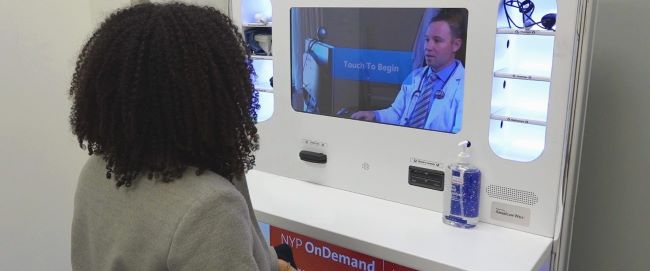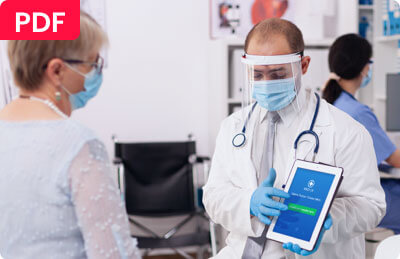Telemedicine Kiosks: A Convenient and Affordable Alternative to Traditional Doctor Visits
Like other industries, healthcare has also revolutionized life standards worldwide in recent years. Self-service kiosks are one of the most outstanding achievements that have revolutionized the workings and services of various industries.
All kiosks are installed to make services efficient and improve customer satisfaction. Similarly, one of the groundbreaking kiosks in the healthcare industry is the telecommunication kiosk.
It is also a healthcare communication service because it operates as a medium between a doctor and a patient. It is the best option for emergency support for patients.
This article will discuss the different kinds of telemedicine kiosk, their importance, and the best method to maintain and monitor kiosks.
- 1 : Telemedicine definition
- 2 : Telehealth vs telemedicine
- 3 : How can telemedicine kiosks benefit patients?
- 4 : MDM plays a crucial role in supporting telemedicine kiosk applications

- 5 : Why choose telemedicine?
- 6 : Different types of telemedicine kiosks
- 7 : How to choose the right telemedicine kiosk?
- 8 : Effect of telemedicine technology on medical care
- 9 : Related questions
Part 1. Telemedicine definition
What is telemedicine?
Telemedicine is the use of telecommunications to provide remote medical care. Telemedicine enables remote consultations between patients, physicians, nurses, specialists, and other healthcare professionals. Video conferencing, phone calls, encrypted messaging, and mobile applications may be utilized for patient-provider communication.
Depending on its capabilities and infrastructure, it may be used for:
Non-emergency situations
Routine examinations
Emergency care
Telemedicine is detrimental to patients who require immediate hospitalization.
What is a telemedicine kiosk?
It is an interactive, self-utilized machine with specialized software to provide clinical support to patients without physically visiting a doctor.
These machines possess high-quality cameras, diagnostic tools, and video screens for doctors to diagnose patients instantly. It has overcome the time consumed at doctor's clinics waiting for the turn.

These kiosks are installed in hospitals, clinics, factories, large retailers, and areas distant from hospitals. It can be used by doctors, nurses, counselors, and specialists to provide remote treatments to their patients.
Patients with diseases can use these self-serve kiosks to consult with their relevant doctors.
How does telemedicine work?
The workings of telemedicine are pretty simple. It includes a telecommunication device, computer, smartphone, or any other digital gadget that connects the patient with a physician to consult and get initial aid in an emergency.
Traditional telemedicine services include an online account or a toll-free number to consult a specific doctor. Digital self-service kiosks have been installed recently to enable telemedicine services in different areas.
These kiosks enable appointment scheduling, virtual consultation, medical assessment, diagnosis, treatment, prescription, and follow-up.
Part 2. Telehealth vs telemedicine
Telehealth and telemedicine are somehow identical, but there is a vast difference in a broader aspect.
Telemedicine is a part of telehealth because telehealth refers to overall remote healthcare services, while telemedicine refers to only remote clinical services.
Telehealth includes:
- Health education
- Administration
- Public health initiatives
- Remote patient monitoring
Telemedicine includes:
- The delivery of medical consultations
- Diagnosis, monitoring
- Treatment of patients
Part 3. How can telemedicine kiosks benefit patients?
Convenience
Telemedicine facilitates patients by getting the consultation remotely. Driving or traveling on public transport with severe illness or pain or in extremely hot or cold weather is challenging.
Chronic patients can regularly consult their doctor remotely with a telemedicine facility, as leaving home and physically appearing at the doctor's clinic is not essential.
Affordable
A telemedicine facility lowers all the traveling costs each time you need a consultation. It might include the fuel cost, transportation, or parking fee. Comparatively, the charges of physical consultancy are higher than telemedicine because many expenditures of hospitals are minimized. Secondly, the costs are kept lower to promote telemedicine in society.
Time-saving
Appointments with doctors can easily be set online to exclude the hurdle of hospital waiting time.
Patients can easily bypass the time-wasting procedures of traditional checkups and get instant assistance from the required doctors using telemedicine. It also helps job holders to quickly provide medical care to their families without affecting their routine tasks.
Part 4. MDM plays a crucial role in supporting telemedicine kiosk applications
Mobile device management solutions play a crucial role in the management and security of telemedicine kiosk devices.
Some ways MDM can help telemedicine kiosks
- Remote Management: Telemedicine is directly concerned with the life of people. Any delay may cause severe issues, so these must be connected with an MDM solution to ensure continuous availability. With MDM solutions, IT admins remotely monitor these devices and provide remote troubleshooting of the issues timely, resulting in minimized downtime.
- Application Management: MDM solutions enable the admins to monitor the activities of the applications installed on the telemedicine kiosks. They also ensure that the devices are continuously updated to be fully functional and secure. With MDM solutions, admins can also restrict several applications to install on the kiosks to prevent damage.
- Security: The security of telemedicine kiosks must be the primary concern because it contains sensitive data. MDM solutions provide the most assertive password policies and data encryption. It enables the admins to set essential password requirements like two-way authentication. You can customize security policies and remotely wipe or remote data if needed.
- Device Tracking: The device tracking feature of MDM is a crucial factor in maintaining the security of devices. Admins can remotely check the real-time location of the telemedicine kiosk and ensure that it is at a suitable place and in the right hands.
AirDroid Business MDM solution is a powerful tool with all the above characteristics and many more to keep the telemedicine kiosks operational and secure for the long term.
Part 5. Why choose telemedicine?
Physicians can use telemedicine to perform remote diagnoses of patients to reduce costs and time. It also reduces the exposure of healthcare professionals and patients to infectious diseases.
During epidemics of highly infectious diseases like influenza and Covid-19, telemedicine reduces the risk of transmission in waiting rooms and clinic rooms. The reduced number of hospital visitors also keeps them safe from viral infections.
Telemedicine enables physicians to monitor, manage, and communicate with chronic patients remotely. This continuity of care reduces problems, hospital visits, and exposure to infectious diseases.
Part 6. Different types of telemedicine kiosks
Here are three basic types of telemedicine kiosks:
Remote Patient Monitoring Kiosk
Kiosks for remote patient monitoring facilitate remote health monitoring. These terminals contain medical devices that monitor and transmit patients' vital signs and health data in real-time.
They may measure blood pressure, heart rate, oxygen, glucose, or weight. Patients may use video conferencing or messaging to manage chronic illnesses and detect anomalies while their data is being monitored.
Real-time telehealth or synchronous telemedicine
Real-time telemedicine kiosks link patients and doctors, and that is why it is also called one-to-one interaction. These kiosks provide HD video and virtual audio consultations.
Digital stethoscopes, otoscopes, and examination cameras enable clinicians remotely check patients. Primary, specialty, urgent, and follow-up care employ real-time telehealth kiosks. Video chat and data monitoring help people manage chronic conditions and find abnormalities.
Store and forward or asynchronous telemedicine
Asynchronous telemedicine kiosk helps transmit medical information. These kiosks enable users to capture and store medical images, videos, and documents for transmission to healthcare professionals.
Telemedicine kiosks are helpful for radiological image assessments and pathology consultations. A dermatological telemedicine kiosk can provide physicians with high-resolution images. Dermatologists can diagnose and treat photographs remotely.
Part 7. How to choose a suitable telemedicine kiosk?
It is necessary to look for the needs and requirements and find which telemedicine machine suits the best. Here are some essential factors to consider when choosing such a kiosk.
Portal Integration of Patient
Determine if the telemedicine kiosk can communicate with the patient portal or EHR software. Due to precise integration, patient information, scheduling, and data exchange can all be accessed swiftly and securely.
It improves the efficiency of physicians and nurses and provides patients with a unified experience. So, checking which telemedical Kiosk integrates with the current software is essential.
User Experience
The selected Kiosk must be user-friendly and interactive for patients and medical staff to avoid hurdles. It has to work for people with varying technical expertise, making patients feel at ease and interested in their virtual sessions.
Portable or Fixed Kiosk
Check whether a portable telemedicine system is better than a stationary kiosk. There are various situations where telemedicine kiosks need to be fixed, and, in some cases, they need to be flexible to move to different locations. So, consider your organization's needs and circumstances before making a decision.
Part 8. Effect of telemedicine technology on medical care
Telemedicine technology has dramatically revolutionized the medical care sector, especially by reducing the waiting time that irritates patients when suffering. The appointment process has become quick and time-saving. Everyone can take points using the telemedicine kiosks without visiting the medical care centres.
- Telemedicine kiosks have different specifications and features, enabling doctors to check patients with different parameters.
- They have enhanced the capabilities of caretakers in the ICU and helped them collaborate more with the hospital staff.
- It is also a cost-effective plan for both patients and hospital management.
- Telemedicine kiosks have also improved patient engagement, and doctors can diagnose diseases instantly with modern tools, reducing patient recovery time.
Part 9. Related questions
Good to know
Telemedicine kiosks are typically used for non-emergency conditions, general checkups, second opinions, and health awareness. Telemedicine kiosks installed in hospitals and large retailers like medical stores create a significant brand impact. Unlike traditional hospitals, telemedicine operates within unlimited areas to serve more patients with instant healthcare services.
But due to extensive exposure, they are highly at risk. These devices need to safeguard with some great solutions to minimize the risks. Mobile device management solutions are one of the best management tools that provide security and help reduce downtime and manage various operations remotely.

AirDroid Business MDM For Healthcare
Efficiently manage a large number of medical mobile devices and update applications, regularly track device abnormal conditions to provide timely remote support, and strengthen the data security protection of patients and hospitals.





Leave a Reply.